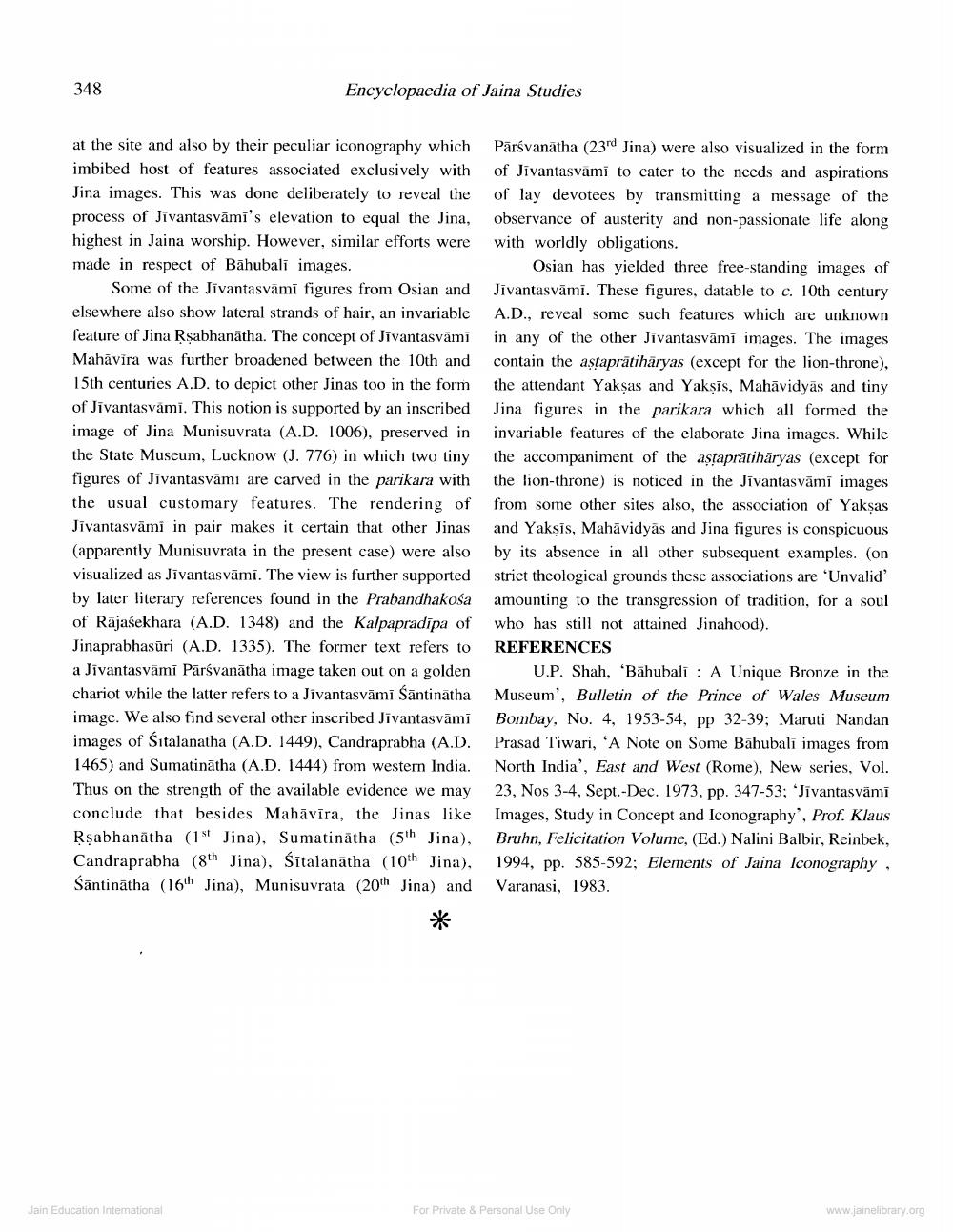________________
348
Encyclopaedia of Jaina Studies
at the site and also by their peculiar iconography which imbibed host of features associated exclusively with Jina images. This was done deliberately to reveal the process of Jivantasvāmi's elevation to equal the Jina, highest in Jaina worship. However, similar efforts were made in respect of Bahubali images.
Some of the Jivantasvami figures from Osian and elsewhere also show lateral strands of hair, an invariable feature of Jina Rşabhanatha. The concept of Jivantasvāmi Mahavira was further broadened between the 10th and 15th centuries A.D. to depict other Jinas too in the form of Jivantasvåmi. This notion is supported by an inscribed image of Jina Munisuvrata (A.D. 1006), preserved in the State Museum, Lucknow (J. 776) in which two tiny figures of Jivantasvāmi are carved in the parikara with the usual customary features. The rendering of Jivantasvämi in pair makes it certain that other Jinas (apparently Munisuvrata in the present case) were also visualized as Jivantasvāmi. The view is further supported by later literary references found in the Prabandhakośa of Rajasekhara (A.D. 1348) and the Kalpapradipa of Jinaprabhasüri (A.D. 1335). The former text refers to a Jivantasvämi Pārsvanātha image taken out on a golden chariot while the latter refers to a Jivantasvāmi sāntinātha image. We also find several other inscribed Jivantasvāmi images of Sitalanatha (A.D. 1449), Candraprabha (A.D. 1465) and Sumatinātha (A.D. 1444) from western India. Thus on the strength of the available evidence we may conclude that besides Mahāvīra, the Jinas like Rşabhanātha (1 5Jina), Sumatinātha (5th Jina), Candraprabha (8th Jina). Sitalanātha (10th Jina), Sāntinātha (16th Jina), Munisuvrata (20th Jina) and
Pārsvanätha (23rd Jina) were also visualized in the form of Jivantasvami to cater to the needs and aspirations of lay devotees by transmitting a message of the observance of austerity and non-passionate life along with worldly obligations.
Osian has yielded three free-standing images of Jivantasvāmi. These figures, datable to c. 10th century A.D., reveal some such features which are unknown in any of the other Jivantasvämi images. The images contain the astaprätihäryas (except for the lion-throne), the attendant Yaksas and Yaksis, Mahāvidyās and tiny Jina figures in the parikara which all formed the invariable features of the elaborate Jina images. While the accompaniment of the astaprätihāryas (except for the lion-throne) is noticed in the Jīvantasvāmī images from some other sites also, the association of Yakşas and Yaksis, Mahavidyās and Jina figures is conspicuous by its absence in all other subsequent examples. (on strict theological grounds these associations are 'Unvalid' amounting to the transgression of tradition, for a soul who has still not attained Jinahood), REFERENCES
U.P. Shah, 'Bahubali : A Unique Bronze in the Museum', Bulletin of the Prince of Wales Museum Bombay, No. 4, 1953-54, pp 32-39; Maruti Nandan Prasad Tiwari, 'A Note on Some Bahubali images from North India', East and West (Rome), New series, Vol. 23, Nos 3-4, Sept.-Dec. 1973, pp. 347-53; 'Jivantasvāmi Images, Study in Concept and Iconography, Prof. Klaus Bruhn, Felicitation Volume, (Ed.) Nalini Balbir, Reinbek, 1994, pp. 585-592; Elements of Jaina Iconography, Varanasi, 1983.
*
Jain Education Intemational
For Private & Personal Use Only
www.jainelibrary.org




